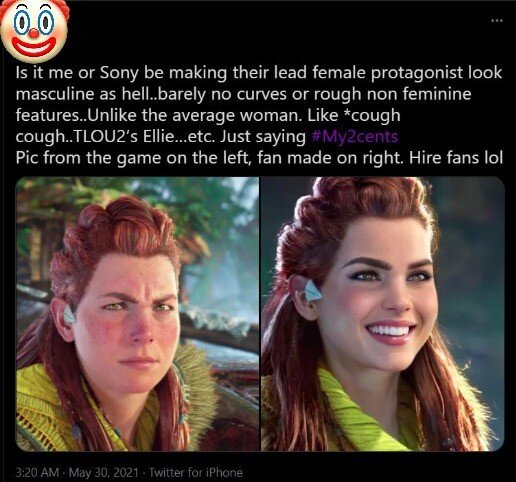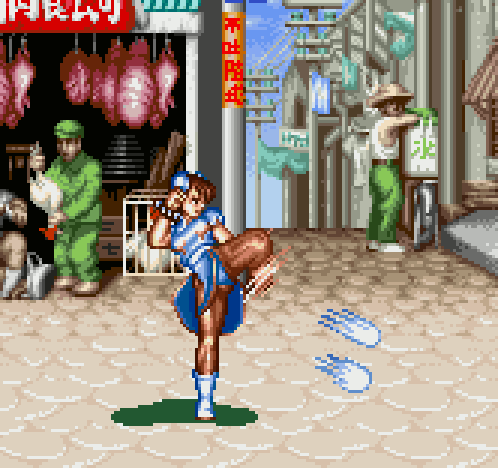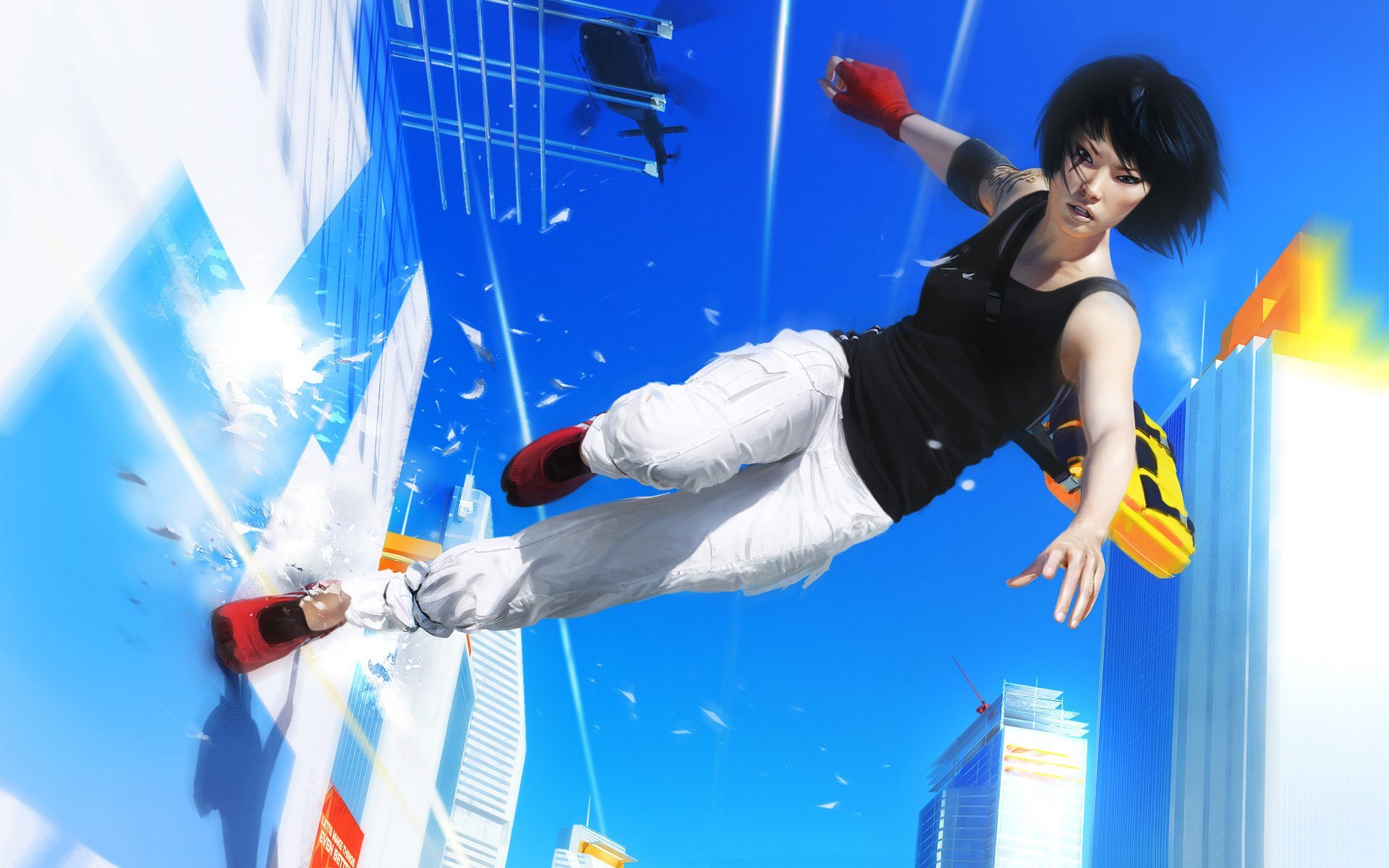As Graphics Improve Unrealistic Beauty Standards and Sexism Become More Clear
Many of my favourite characters in video gaming are women. Evie Frye (to whom I’ve been compared more than once), Nadine Ross, Ellie. These are but a handful of the names I would count among those at the top of my favourites list. Each is part of a plotline that is engaging and each drew me into loving games as much as I do now.
Badass ladies have been at the forefront of games since the beginning. But like a bug deep in a game’s code that a developer just can’t fix, misogynistic designs and portrayals have persisted in games for decades just beneath the surface.
Aloy on the right looks like she is about to tell me about a great new toothpaste.
This brings us to last week when with only 14 minutes of content for Horizon Forbidden West some ‘fans’ took it upon themselves to shut down and criticise the evolution of Aloy’s character design for being “too chubby” compared to her look in Forbidden Dawn.
One of the concept artists for Horizon Forbidden Dawn, Lois Van Baarle even mentioned in the game’s artbook that Aloy (in particular hair and appearance) was designed to be full of expression while also realistic for a huntress in the middle of the wilds where beauty is a luxury and not the main agenda. Yet we still have a subset of gamers that decry this clever character and world building as the defeminisation of characters to appease the woke mob.
Fun fact: anyone who has ever said they could beat Abby in a fight would absolutely get their ass handed to them by her.
And this has happened more than once; a female protagonist is announced for a game and the internet will say she’s not pretty enough because she’s without makeup or too “masculine”. Eivor from Assassin’s Creed Valhalla and Kassandra in Odyssey, and Laura Bailey’s character Abby in The Last of Us: Part II all sparked conversation about her muscles with certain groups on the internet trying to “debate” whether it was even possible.
These bad faith arguments were gross for numerous reasons. From Abby’s physique being possible and realistic in a post-apocalyptic survivalist world. To the fact that many of these arguments claimed she must be a closeted trans-character, implying 1) that trans women aren’t real women, 2) that trans women can’t be feminine and 3) ciswomen can’t be muscular. For the record, Abby’s physique is on par with Olympic athletes or professional Crossfit competitors.
(Also I’m sorry but Abby’s arms are goals.)
Chun Li has been doing this since 1991.
Hell, even Chun Li from Street Fighter is muscular and has been since her earliest appearance from Street Fighter II. She in particular proves that a female character can be both muscular and hold a ‘sexier’ appearance, as opposed to being either one or the other.
Ellie and Aloy are characters with their own strengths (and flaws!) and it is what makes them perfectly rounded individuals. It’s what drew me to them. Not because they have flawless lipstick or perfect contouring (neither of which I know how to do myself).
This thinly veiled body-shaming needs to stop, and it needed to stop years ago. Women are all shapes and sizes, they have blemishes, freckles, scars. They might wear makeup and not. Makeup doesn’t magically give us special abilities… Although it would make an interesting game mechanic now we’re thinking about it. If winged eyeliner could genuinely give me the ability to fly, then I might actually be tempted to learn.
This, however, isn’t just an issue with games released five, ten or more years ago. This is a problem right now. As more women are becoming main characters in more games, the casual sexism in responses to female character models is becoming more clearly evident.
Recently, there was a wave of Chinese game developers that spoke out about the ingrained sexism in the industry. This came after the CEO of Game Science, Feng Ji, posted that the reaction to his company’s highly anticipated Black Myth: Wukong made him, “licked so much that [he] could no longer get erected”. One anonymous female developer in Chengdu even stated a higher-up had given instructions for design a female character with the notes that they should base the “sexy” appearances around being believable fuck-able.
Those Quantic Dream reports really reframe a lot already unnecessary scenes in David Cage’s games.
Western Studios most certainly aren’t exempt from this either. Quantic Dream, the French studio behind Heavy Rain, has seen employees sue over its toxic culture within the workplace, where sexist and homophobic comments and generally inappropriate behaviour was trivialised and complaints disregarded. With everything from inappropriate comments being a regular occurrence to a picture of a penis with farting testes hanging on an office wall.
And let’s not forget the reports from Ubisoft which, in the Summer of 2020 saw many female employees and fans of its franchises share their own #MeToo stories about sexual misconduct regarding several major figures within the company. Follow up reports a year later stated that in some cases toxic behaviour had actually increased during the period in which employees worked from home during lockdown. This culture shows and impacts the games themselves. With higher-ups reportedly pressuring devs to not make Aya (in Origins) and Kassandra (in Odyssey) the canonical main protagonists. Warping creatives’ vision to demote and de-emphasise strong female characters.
.... I have no response to this that doesn’t involve swearing.
Thankfully some games are changing. Famously, Lara Croft’s reboot games saw a more athletic build for the adventuring archaeologist; no triangular boobs to find here, but instead more muscles and sensible clothing for harsh temperatures and dangerous situations. Chel’s outfit in Portal is a sensible jumpsuit and shirt. Both of these women have muscle and athletic designs and both are attractive women, neither dolled up in makeup because someone thought it was sexy or something.
This is in stark contrast to Resident Evil’s Jill Valentine or Middle-Earth: Shadow of Mordor’s Eltariel, who despite murdering zombies all day and living in Middle Earth, respectively, somehow have found the time to work on their concealer.
Question: Is Faith one of the top 5 coolest video game character’s of all time?
Answer: Yes.
However, that isn’t to say sexiness or overt feminity is the enemy. Evie Frye fights in heeled boots (standard fashion for the Victorian Period in which AC Syndicate was set) but you would not want to be on the receiving end of her brutal takedowns in the fight clubs? Faith is instantly recognisable thanks to her beautiful facial tattoos (that would be easily mistaken for makeup). But she doesn’t wear some elaborate costume, instead, she wears a simple tracksuit in Mirror’s Edge. Her outfit helps show her skill and pinpoint utilitarianism that comes with years of training, while still portraying her as an inherently attractive character.
Even tropes that usually result in one-dimensional characters can be evolved to become something much more profound. For years, most female characters in games acted as simple love interests/rewards for the player to earn, but look at Senua’s story in Hellblade. She is driven by love but not a sexualised kind and she is certainly not a damsel in distress. She is fighting the Norse goddess of Death herself, in a brutal tale of survival but it is still centred around a deep affection for another.
Do not piss Evie off.
These women aren’t there for you to lust over; they’re active participants in their character arcs, and if they want to wear makeup or a dress they will. They wear what is practical when they want to. They’ll do what they damn well please.








![Here’s a Rundown of Everything Show at The Summer Games Fest Kick-off Livestream [10/06/2021]](https://images.squarespace-cdn.com/content/v1/5caf2dea93a63238c9069ba4/1623451322403-IETFEI48F6VSK5QB4G4A/summer+games+fest+0.jpg)



